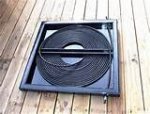I made one using plywood, 2x4s, black spray paint, and black HD garden hoses that my wife found somewhere on Pinterest or something. This link and image gives you the idea of how it all comes together, to a degree.
http://www.ehow.com/how_5140256_build-passive-solar-pool-heater.html
This pic is what mine looks very similar to. I have seen guys cover it with Plexi-glass to retain heat, but I haven't done that to date.

We are in WI, so in addition to needing a good solar cover, a gas/electric/propane/etc. heater is almost a necessity to make a pool worthwhile here. We had a lousy old inefficient Hayward Propane heater that I pulled off site when we bought the house (w/ pool). The solar cover they had was on it's last legs, so we purchased a clear thick 16 mil new solar cover, which has proven to be one of my best expenses to date. It blows any blue one I've ever owned or seen out of the water, no pun intended.
I put a tee in my pool return line with a PVC shut off valve after the tee. Necked down the bottom outlet fitting (3rd leg) of the tee to a 3/4" hose thread and I feather the valve to steer enough of the water out thru the tee to my coiled up heater to push water at a slow rate and into the pool....but only when I plan on utilizing the heating feature. Pressure gauge on the pump jumps to about 7-8 psi but still leaving a good amount of water coming thru the return. Isaac's discussion above I assume revolves around a system that is working ANY time the pump system is on...I didn't want that for a variety of reasons, so I have the passive set-up that I can control. I own a 28' round Doughboy Tuscany that happens to have the waterfall feature, so the heated water enters the pool thru that fitting under the rail and out thru the waterfall and not from an ugly hose hanging over the edge of the pool in plain sight. Every day with full sun from pool opener thru the summer, we have a timer that will turn the pump on at 11 AM and then run for 30 minutes and then again at 2 PM and run for another 30 minutes. I can't stress how warm that water is that comes out of there, and I should measure it with a thermometer but you can hardly touch it when it trickles into the pool. Not sure what the weekly or daily gains are, but I know it has helped dramatically versus using just the solar cover. You've all felt water coming out of a hose that laid in your yard in the sun for a good bit and how hot the water is right after you turn it on...same results/same principle.
With that, I plan on revising this thing next year and utilizing 1/2" black irrigation line to replace the 3 x 50' black garden hoses. I'll have more surface area for water heating versus a 5/8" HD rubber hose...(there will be no kinks in this material as the hose always gets a kink somewhere, if not more than one spot, and this effects water pressure and efficiency.) It also weighs about a 10th of what the assembly with garden hoses weighs (when empty) for storing this unit in the winter months. I added 2 lawnmower wheels on mine last year to move it and transport it. Also note....depending on where you live, each months has a different relative angle from your location to the sun, based on the angle to Earth, so if you plan on putting it on the ground and not on your roof, keep that in mind. You can find that info right here:
http://www.gogreensolar.com/pages/solar-panel-tilt-calculator
Worth noting that if you store something like this in the winter months and you live in a cold climate, you need to use an air compressor to blow out most, if not all, of the water out of the lines to avoid rupture issues.


